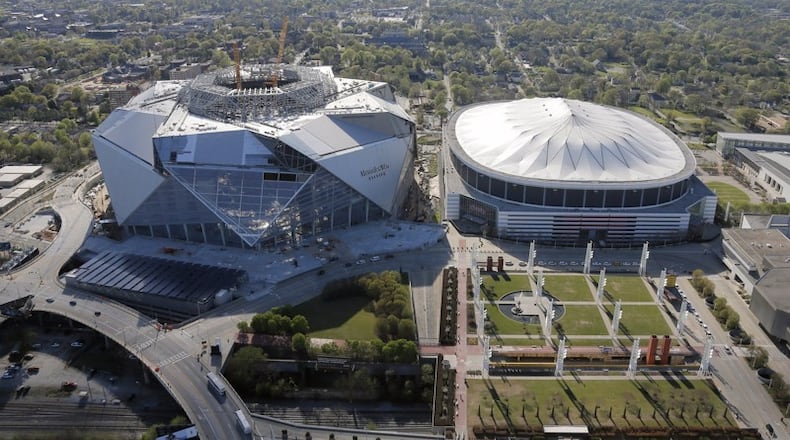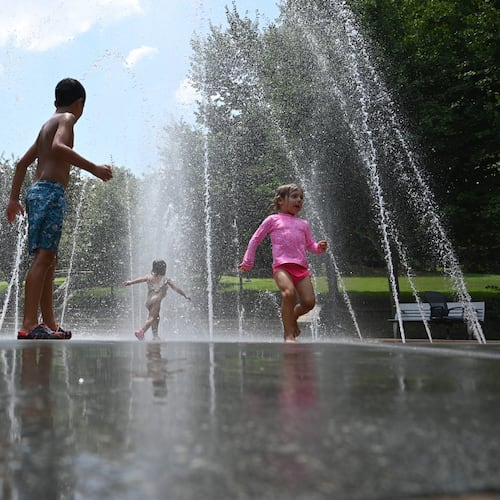The Atlanta Falcons’ move from the Georgia Dome to Mercedes-Benz Stadium is a big venue change, but it is not causing the stir the Braves’ immigration to the suburbs has caused. The SunTrust Park move has gotten due scrutiny, because of the foreseen effect on the traffic in the busy Cumberland corridor.
So far, Braves traffic has not been quite as bad as expected fortunately. The Falcons are moving, oh, about 100 yards to the south, so their traffic plan needs far less of an introduction. But AMB Entertainment (Arthur Blank’s company) officials have made tweaks in preparation for the late summer opening of Blank’s crown jewel facility.
AMB hosted local Atlanta traffic reporters for a Wednesday walk-around of the facility and a Q&A session. The AMB brain trust is taking some pages from the Braves’ playbook (that hopefully have nothing to do with that awful, error-filled third inning last Tuesday night).
For Falcons games, Atlanta United matches, college football and basketball games and concerts at MB Stadium, AMB urges fans to purchase parking beforehand and then navigate using Waze directly to the address of each lot. They are making sure each lot has a color-coded name and that signage in the area directs people to specific lots and not just to the MB Stadium property. Previous NFL traffic studies had shown that lousy signage was one of the biggest problems around the Dome.
Capacity for Falcons games at MB Stadium is roughly 71,000 - same as the Dome. But the stands can expand to 75,000 for college football games and about 83,000 for a marquee basketball game. Parking will remain at 20,000 to 23,000 spaces within 15-20 minute walks of the stadium and in all directions around the grounds.
AMB officials heavily encourage people to use Northside Drive between MB Stadium and I-75.
Eric Waldman, Georgia World Congress Center Senior Director of Client and Guest Services, says that his team and Georgia DOT work closely to time the traffic lights on Northside Drive to move traffic up and down that corridor more efficiently around big events.
Waldman’s team operates a traffic management center inside the GWCC. They also suggest trying to bypass the busy Williams St. exit off of I-75/85 and go down to the Martin Luther King Jr. Drive exit and head west to MB Stadium.
NFL traffic studies, maybe surprisingly, rank Atlanta in the top 10 for its traffic plan around its venue. Access to MARTA is a key part of this, with Atlanta also ranking tops in these studies in public transit access. AMB says 20-30 percent of fans take MARTA to events at the Dome and will to MB Stadium. Among these, 80 percent use the Dome/GWCC/CNN/Philips Arena stop and 20 percent use Vine City just to the west. Many fans use the north-south Red Line and change trains at Five Points. The train-changing causes a bottleneck, even though MARTA houses extra trains in a train “pocket” beneath the property, so officials want fans to try and walk directly to Five Points or park at stations along the Blue/Green east-west lines. Personally, I live in Tucker and drive to Kensington or Decatur and then take MARTA to games.
Finally, MB Stadium will have Uber dropoff and pickup zones in specific areas and will actually geo-code a buffer inside the Uber app, to prevent idling drivers outside the zones from showing up for fans to use. This will force Uber and other rideshare services like Lyft from hampering the traffic flow, by stopping in inconvenient areas.
Overall, the Mercedes-Benz traffic plan is not jaw-dropping or groundbreaking. The framework was already in place and AMB officials are splicing in some good ideas that other teams, like the Braves, use. Events at the stadium will undoubtedly cause extra traffic, but at least traffic light-timing, alternate routes and public transportation will help ease the pain.
About the Author
The Latest
Featured


